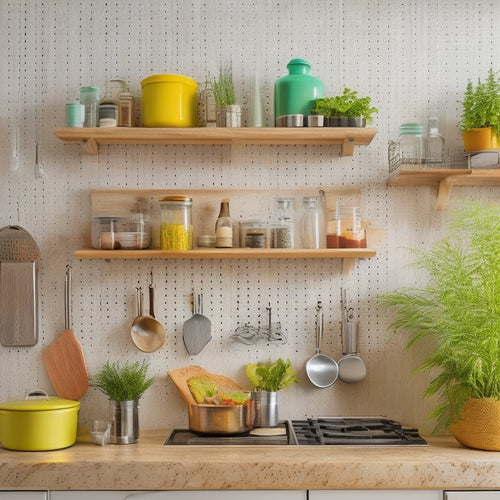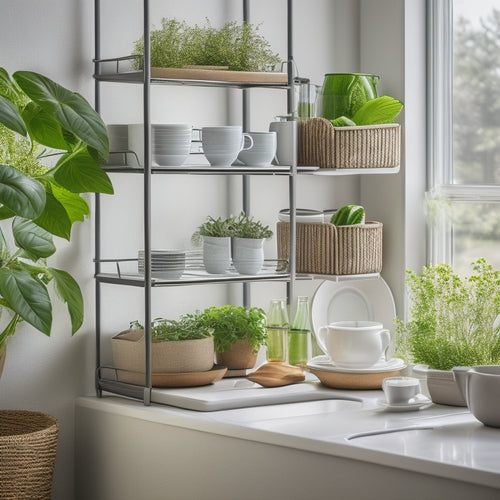
Organize Meal Prep Containers for Easy Kitchen Access
Share
You've got your meal prep containers, now it's time to get them organized for easy kitchen access. Start by evaluating your meal prep habits and choosing containers that fit your needs. Assign a storage space that's easily accessible, like a pantry or under-cabinet storage. Maximize vertical storage options with stackable shelves or wall-mounted solutions. Label and categorize your containers by content, date, or meal type for quick identification. Designate zones for prep, cooking, and storage to keep your kitchen efficient. By implementing these strategies, you'll be well on your way to a clutter-free kitchen that makes meal prep a breeze - and that's just the beginning.
Key Takeaways
• Determine container sizes and quantities based on meal prep frequency to optimize storage space and accessibility.
• Designate zones and accessible meal prep stations for efficient container storage and workflow.
• Label containers with contents and dates for easy identification and implement a categorization system for quick access.
• Utilize vertical storage options, such as stackable shelves and wall-mounted solutions, to maximize kitchen storage space.
• Implement a regular cleaning and maintenance schedule to prevent clutter and maintain a hygienic kitchen environment.
Assessing Your Meal Prep Needs
Before you start organizing your meal prep containers, take stock of your meal prep habits and determine how many containers you need for a typical week. Consider your family meal planning and the number of meals you prep in advance. This will help you decide on the right container sizes and quantities.
Think about your pantry organization and kitchen layout, too. Where do you typically store your containers, and how easily can you access them?
Next, assess your meal prep frequency. Do you prep daily, weekly, or somewhere in between? This will impact the number of containers you need and how often you'll need to wash and reuse them.
Consider your cooking style, too. Do you prep individual portions or cook in bulk? This will influence the size and type of containers you require.
Choosing the Right Storage Space
Set up a storage space that's easily accessible and convenient for you, as this will encourage you to maintain your meal prep routine. Consider the areas in your kitchen where you spend most of your time cooking and preparing meals. This will help you determine the best storage location for your meal prep containers.
Look into pantry organization systems or under cabinet storage solutions to keep your containers out of the way but still easily accessible. You can also utilize fridge storage bins or drawer solutions to store ingredients and leftovers, keeping them fresh and organized.
When choosing a storage space, think about the frequency of use and the size of your containers. Labeling your storage space can also help you quickly identify where everything is, saving you time and reducing frustration.
Maximizing Vertical Storage Options
Now that you've identified the perfect storage space, it's time to make the most of it by maximizing your vertical storage options.
You'll want to think strategically about how to use every inch of space, from floor to ceiling, to keep your meal prep containers organized and easily accessible.
Stackable Shelf Options
Maximize your kitchen's vertical space by selecting stackable shelf alternatives that can accommodate multiple meal prep containers, maintaining them organized and easily accessible. This space-saving solution is ideal for kitchens with restricted counter space or storage. By utilizing stackable shelves, you can store more containers in a smaller area, facilitating the location of necessary items.
Here are some advantages of utilizing stackable shelf alternatives:
-
Simple to clean: Stackable shelves are typically crafted with easy cleaning in consideration, simplifying the process of wiping surfaces and eliminating any food residue.
-
Tailored: Opt for various shelf sizes and arrangements to suit your specific container customization requirements.
-
Pantry arrangement: Utilize stackable shelves for arranging your pantry, ensuring that meal prep containers and other kitchen essentials are easily reachable.
- Safety priority: Seek shelves with robust construction and stable support to prevent mishaps and guarantee the stability of your containers.
Utilize Wall Space
You can further optimize your kitchen's vertical space by installing wall-mounted storage solutions that hold your meal prep containers, keeping them organized and within easy reach. This will create a safe and clutter-free environment, allowing you to focus on meal prep without obstacles.
Consider using magnetic hooks to hang your containers, freeing up counter space and keeping frequently used items within arm's reach. Hanging baskets are another great option, providing a convenient spot to store lids, utensils, or other kitchen essentials.
Don't forget about the often-wasted space on the back of doors. Install door racks to store additional containers, spices, or oils, keeping them organized and easily accessible. For a more customizable solution, consider pegboard storage. This allows you to arrange hooks, baskets, and other storage solutions to fit your specific needs and container sizes.
Adjustable Height Bins
By incorporating adjustable height bins into your meal prep container storage, you can create a flexible and tailored system that adapts to your unique needs and container sizes. This space-saving solution allows you to maximize your vertical storage options, keeping your kitchen countertops clutter-free and organized.
With adjustable height bins, you can:
-
Store containers of varying sizes, from small to large, in a single bin
-
Easily access and retrieve containers without having to dig through a pile
-
Customize the bin's height to fit your specific storage needs
- Keep your kitchen organized and tidy, reducing stress and increasing productivity
Labeling and Categorizing Containers
Labeling each container with its contents and date helps to quickly identify what's inside and guarantees you're consuming the oldest items first. A labeling system is a simple yet effective way to organize your meal prep containers. You can use stickers, labels, or even a permanent marker to write the contents and date on each container. This system guarantees you'll never have to dig through containers to find what you need, saving you time and reducing frustration.
To take your organization to the next level, consider color coding your containers. Assign a specific color to each type of food, such as green for vegetables or blue for proteins. This visual system makes it easy to find what you need at a glance. Additionally, categorize your containers by meal type, such as breakfast, lunch, or dinner. This helps you plan your meals and guarantees you're using the oldest items first.
Designating Zones for Easy Access
Now that you've labeled and categorized your meal prep containers, it's time to designate zones for easy access.
You'll want to create a meal prep station where you can quickly grab the containers you need, and organize them by category to save time and reduce clutter.
Meal Prep Station
Create a meal prep station by designating zones within your kitchen that cater to specific tasks, allowing you to access utensils, ingredients, and equipment effortlessly. This organization hack will revolutionize your meal prep routine, making it faster and more efficient.
By dividing your kitchen into zones, you'll reduce clutter and increase kitchen efficiency.
Here are some essential zones to take into account:
-
Prep Zone: Designate a specific area for chopping, slicing, and dicing ingredients. This zone should be equipped with a cutting board, knife block, and utensil organizer.
-
Cooking Zone: Allocate a zone for cooking, complete with a stove, oven, and cooking utensils.
-
Storage Zone: Assign a zone for storing meal prep essentials, such as containers, lids, and labels.
- Cleaning Zone: Designate a zone for cleaning and sanitizing, equipped with a sink, soap, and cleaning supplies.
Container Categories
To maximize storage efficiency and accessibility, categorize your meal prep containers into zones based on their frequency of use, size, and type. Ensure that your most-used containers are easily within reach. This system allows you to quickly grab what you need, saving you time and reducing kitchen clutter.
Divide your containers into categories, such as daily use, weekly prep, and special occasion containers. Within each category, group similar containers together, like all your salad containers or breakfast containers. Consider color coding your categories using labels or stickers to make them easily identifiable. This visual system will help you locate the right container in a snap.
When grouping containers, keep portion control in mind. Store smaller containers for individual portions near the front of your storage area, making it easy to grab a single serving. Larger containers for bulk prep can be stored towards the back. By organizing your containers into zones, you'll create a safe and efficient kitchen space that makes meal prep a breeze.
Maintaining a Clutter-Free System
Set a weekly reminder to wipe down and sanitize your meal prep containers to prevent residue buildup and keep them looking like new. This habit won't only keep your containers clean but also maintain a clutter-free system in your kitchen.
To take it a step further, make sure you:
-
Declutter your countertops by storing infrequently used containers in your pantry or cabinets, keeping only the essentials within easy reach.
-
Utilize cabinet space by installing shelves or dividers specifically designed for meal prep containers, ensuring efficient storage and easy access.
-
Implement a 'clean as you go' policy, washing and putting away containers immediately after use to avoid piling up dirty dishes.
- Schedule a monthly deep clean of your pantry and cabinets to remove any expired or spoiled food and wipe down shelves to prevent pest infestations.
Frequently Asked Questions
Can I Use Old Plastic Containers for Meal Prep Storage?
'Thou shalt not sacrifice safety for thrift!' When reusing old plastic containers for meal prep, make sure they're BPA-free, airtight, and clean. If not, consider recycling options or upgrading to safe containers that'll keep your grub fresh and healthy.
How Often Should I Wash and Sanitize My Containers?
You should wash and sanitize your containers at least weekly to prevent bacterial growth. Guarantee proper storage by drying them thoroughly after cleaning, and store them in a clean, dry place to maintain their safety.
Are Glass Containers Better Than Plastic for Meal Prep?
You're wondering if glass containers are better than plastic for meal prep? Glass wins for sustainability benefits and durability, plus it's healthier since it doesn't leach chemicals, and it's better for the environment.
Can I Store Cooked and Raw Meat in the Same Container?
Imagine a kitchen nightmare: bacteria from raw meat contaminating your cooked meals! To avoid this, you'll want to store cooked and raw meat in separate containers to prevent cross contamination and guarantee food safety.
How Do I Prevent Moisture Buildup in My Containers?
To prevent moisture buildup, you'll want to maintain proper ventilation in your containers. Try using lids with ventilation holes or placing a paper towel inside to absorb excess moisture, preventing condensation and keeping your food safe.
Related Posts
-

Stylish Pegboard Storage for Open Kitchen Concepts
Stylish pegboard storage can completely enhance your open kitchen concept, merging practicality with contemporary fla...
-

Tiered Dish Rack Organizers for Compact Spaces
Tiered dish rack organizers are perfect for compact spaces, maximizing vertical storage while saving precious counter...
-

Under-Sink Storage Bins for Organized Kitchens
Under-sink storage bins are your best bet for an organized kitchen. They maximize unused cabinet space and enhance it...


